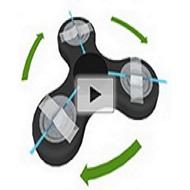
Credit: American Chemical Society
Some people use fidget spinners — flat, multi-lobed toys with a ball bearing at the center — to diffuse nervous energy or whirl away stress. Now, researchers have found a surprising use for the toys: separating blood plasma for diagnostic tests. The new approach, reported in ACS’ journal Analytical Chemistry, could be useful for medical applications in regions of the world that lack electricity and other resources. Watch a video of the spinner in action here.
Before doctors can perform many types of blood tests, they must separate blood cells from plasma, the yellowish fluid that contains proteins, bacteria, viruses, metabolites and other substances that can be used to diagnose disease. This is most often accomplished by centrifugation, which uses high-speed rotation to sediment blood cells. However, centrifuges are expensive and require electricity that might not be available in resource-limited regions. Chien-Fu Chen, Chien-Cheng Chang and colleagues wondered if a commercially available fidget-spinner could generate enough force to separate blood plasma with the flick of a finger.
To find out, the researchers placed human blood samples in tiny tubes, sealed the ends and taped a tube to each of the three prongs of a fidget-spinner. They found that by flicking the spinner with a finger three to five times, they could separate about 30 percent of the plasma with 99 percent purity in only four to seven minutes. To verify that the plasma was suitable for diagnostic tests, the researchers spiked blood with a human immunodeficiency virus-1 (HIV-1) protein, separated the plasma with the spinner and performed a paper-based detection test. The inexpensive, simple method detected clinically relevant concentrations of the viral protein in only a drop of blood.
###
These authors acknowledge funding from the Ministry of Science and Technology, Taiwan, and National Taiwan University.
The abstract that accompanies this study is available here.
The American Chemical Society, the world’s largest scientific society, is a not-for-profit organization chartered by the U.S. Congress. ACS is a global leader in providing access to chemistry-related information and research through its multiple databases, peer-reviewed journals and scientific conferences. ACS does not conduct research, but publishes and publicizes peer-reviewed scientific studies. Its main offices are in Washington, D.C., and Columbus, Ohio.
To automatically receive news releases from the American Chemical Society, contact [email protected].
Follow us on Twitter | Facebook
Media Contact
Katie Cottingham
[email protected]
301-775-8455




